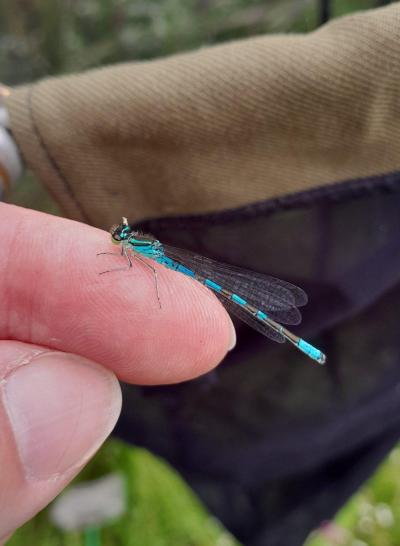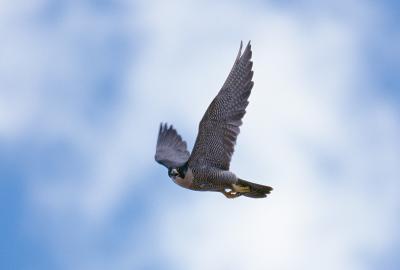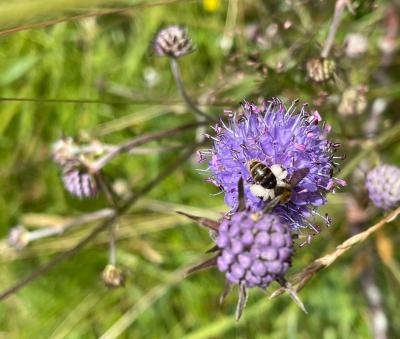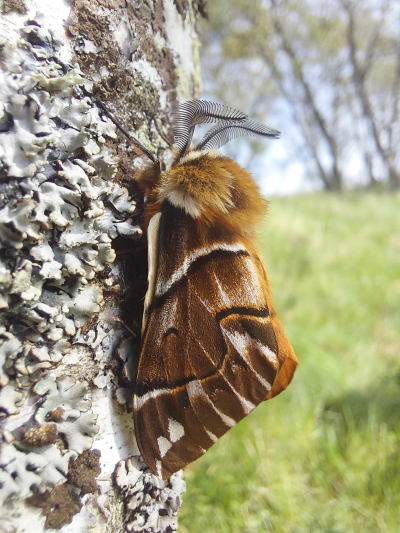Pinewood mason bee
Osmia uncinata
The pinewood mason bee is a tiny bee, about the size of a thumbnail. It nests in the bark of mature pine trees and forages on the flowers of bird’s-foot trefoil.
Factsheet
Lifespan: One to two years
Best time to spot: Mid-May to mid-June
Pinewood mason bees are elusive and tricky to spot. At 10mm long, they are very small, much smaller than a honeybee or bumblebee, and only fly on warm, dry days.
The pinewood mason bee mainly lives in Caledonian pine woodland, typically in spacious locations such as glades and south-facing forest open edges. These provide flowers for foraging and enough sunshine to warm the nest. It’s in these sunny forest openings that birds-foot-trefoil, one of the bee’s primary food sources, grows. This plant likes lightly grazed land, where grass and other undergrowth is kept shorter. The bee will also visit more than 10 other plant species to drink nectar.
The pinewood mason bee has six legs and four wings. These wings look almost translucent and starkly contrast with their delicate, dark veins.
Unlike other types of bee, which carry pollen on their legs, mason bees carry pollen underneath their abdomen. A distinctive yellow underbelly gives them away after they’ve gathered lots of pollen.
Did you know?
The pinewood mason bee is a tiny bee, about the size of a thumbnail. It nests in the bark of mature pine trees and forages on the flowers of bird’s-foot trefoil.
Factsheet
Lifespan: One to two years
Best time to spot: Mid-May to mid-June
Pinewood mason bees are elusive and tricky to spot. At 10mm long, they are very small, much smaller than a honeybee or bumblebee, and only fly on warm, dry days.
The pinewood mason bee mainly lives in Caledonian pine woodland, typically in spacious locations such as glades and south-facing forest open edges. These provide flowers for foraging and enough sunshine to warm the nest. It’s in these sunny forest openings that birds-foot-trefoil, one of the bee’s primary food sources, grows. This plant likes lightly grazed land, where grass and other undergrowth is kept shorter. The bee will also visit more than 10 other plant species to drink nectar.
The pinewood mason bee has six legs and four wings. These wings look almost translucent and starkly contrast with their delicate, dark veins.
Unlike other types of bee, which carry pollen on their legs, mason bees carry pollen underneath their abdomen. A distinctive yellow underbelly gives them away after they’ve gathered lots of pollen.
Did you know?
The female’s nest is made up of cells made with plant material and her own saliva, constructed in the thick bark of mature pine trees. She lays a single egg into each cell, as well as a ball of ‘bee bread’ made with pollen and nectar. The larvae that hatch from the egg feed on the bee bread then pupate, only emerging as adults the following summer.
Only a scattering of records in the UK exist for this species – and all originate in the Scottish Highlands.
Efforts have been made to better understand the habitat needs of this bee and search for new sites, but the Cairngorms National Park currently holds the most records for this nationally rare species. Its elusive nature means we still don’t fully understand the bee’s population in the region, but it’s unlikely to be an abundant species.
Local extinctions could occur where forest management isn’t sympathetic to its needs. Creating sunny forest edges and rides where bird’s-foot-trefoil can grow is crucial: a step that could be integrated into routine forest management.












